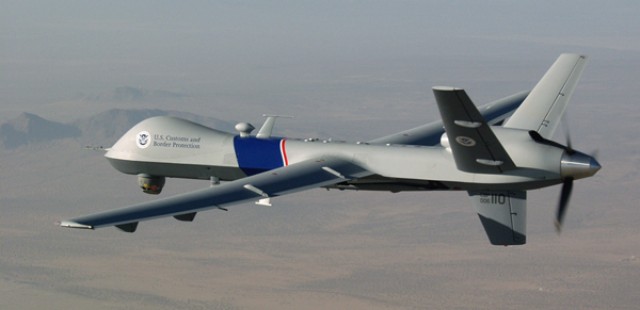Federal law enforcement authorities are rapidly expanding a military-style unmanned aerial reconnaissance operation along the US-Mexico border.
Fans of the Predators say the $20 million aircraft are a perfect platform to keep a watchful eye on America’s rugged borders, but critics say the drones are expensive, invasive and finicky toys that have done little — compared with what Border Patrol agents do on the ground — to stem the flow of illegal immigrants, drug smugglers or terrorists.
Eight Predators fly for the Customs and Border Protection agency — five, and soon to be six, along the southwestern border. After a slow rollout that began in 2005, drones now patrol most of the southern boundary, from Yuma, Arizona, to Brownsville, Texas.
For supporters, Predators are the new, sexy, futuristic fix for immigration control. They are irresistible to border hawks and the “Drone Caucus” in Congress, who consider the aircraft a must-have technology to meet the threat of spillover violence — yet unrealized — from Mexican drug cartels.
Rep. Brian Bilbray (R-Calif.) has said that the drones are so popular that a Predator could be elected president. Rep. Henry Cuellar (D-Tex.) pronounced domestic drones “invaluable.” Arizona Gov. Jan Brewer (R) called them “ideal for border security and counter-drug missions.” Texas Gov. Rick Perry, a GOP presidential contender, argues that the solution to security along the frontier is not a border fence but more Predators.
In his trips to testify on Capitol Hill, Michael Kostelnik, the retired Air Force general and former test pilot who runs the Office of Air and Marine for the CBP, said he has never been challenged in Congress about the appropriate use of domestic drones. “Instead, the question is: Why can’t we have more of them in my district?” Kostelnik said.
Planning documents for the CBP envision as many as 24 Predators and their maritime variants in the air by 2016, giving the agency the ability to deploy a drone anywhere over the continental United States within three hours.
The drones, though operated by the CBP, have been deployed to assist sister law enforcement agencies. This month, the Los Angeles Times reported that Predators were used in North Dakota to help police run down a trio of ordinary crime suspects in a cow pasture.
One of the first Predators deployed by the border service crashed in 2006 when its remote pilot, a contractor for the plane manufacturer General Atomics, turned off the engine by mistake. The plane missed a residential area by 1,000 feet as it plunged.
U.S. protocols require the drones to stay on the American side of the Rio Grande. “We don’t do Mexico,” said Lothar Eckardt, director of the Homeland Security Department’s National Air Security Operations Center in Corpus Christi.
But the aerial platforms do peer a little over the fence into Mexico.
What can they see? “We can see cows, pigs, coyotes, sometimes rabbits,” Lothar said. “At 20,000 feet, you can see windshield wipers, you can see if a person is running or walking, you can see backpacks sometimes. We can see Border Patrol, but not their uniforms, and so we can communicate with them and say, ‘Wave your arms,’ and that way we can distinguish between our guys and the bad guys.”
Despite its initial reluctance, the Federal Aviation Administration allows the drones to fly a high-altitude corridor along the Mexican and Canadian borders but forbids them over congested urban areas — for safety, not privacy, concerns. Because of the orientation of the runway at the Corpus Christi Naval Air Station, the Predators are grounded when the wind direction requires them to pass over a neighboring suburb.
The Predators reached a milestone in June, having flown 10,000 hours. The Homeland Security Department reported that their drone operations have led to the apprehension of 4,865 undocumented immigrants and 238 drug smugglers since the program began.
Those numbers are not very impressive. A total of 327,577 illegal migrants were caught at the southwestern border in fiscal 2011, meaning the drones have contributed only to a fraction of arrests.
With an hour of flight time costing $3,600, it costs about $7,054 for each illegal immigrant or smuggler caught, based on numbers calculated from a recent Government Accountability Office report to Congress. The government has spent $240 million buying and maintaining its domestic drones, not including their operation.
It is hard to put a dollar value on the services the Predators can supply, Kostelnik said, citing as an example a scenario in which a nuclear reactor, like the one in Japan damaged by the earthquake and tsunami in March, needed to be inspected from the air.
“What is the value of a ‘can’t be seen, can’t be heard’ technology when you absolutely, really need it?” Kostelnik said. “The unmanned aircraft does things nothing else can do.”
The authors of the GAO report were not so sure. They highlighted an obscure programme called “Big Miguel” run by the Joint Task Force North out of the Army’s Biggs Field in El Paso that leased a piloted Cessna with an infrared sensor that cost $1.2 million for the year and assisted in the capture of 6,500 to 8,000 undocumented immigrants and seizure of $54 million in marijuana, according to defense officials. That would make the Big Miguel cost per illegal immigrant caught about $230.
“Congress and the taxpayers ought to demand some kind of real cost-benefit analysis of drones,” said Tom Barry, director of the TransBorder Project at the Center for International Policy, a Washington think tank, who has studied the domestic Predator program. “My sense is that they would conclude these aircraft aren’t worth the money.”
Source: The Washington Post

